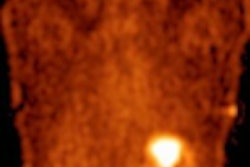TORONTO - Multimodality vendor GE Healthcare is launching a new premium PET/CT scanner at this week's Society of Nuclear Medicine (SNM) meeting. The Chalfont St. Giles, U.K., company is also highlighting a new cyclotron, radiotracer lab, and bone reconstruction algorithm.
Discovery STE is designed to have better image quality and be more flexible than the company's Discovery ST unit, GE's flagship PET/CT scanner up to now. Discovery STE uses a new console, Discovery Dimension Console, that has a number of new features. Users can tailor CT radiation dose to individual patients, acquire 4D images without rescanning patients, use CT slices of different thicknesses during the same exam, and acquire diagnostic IV contrast CT images during PET/CT studies.
The first commercial Discovery STE system has been installed at a hospital in Finland, and GE expects 20 systems to be installed by the end of 2005. The scanner is available in eight- and 16-slice CT versions. Discovery ST will remain in GE's product portfolio, though Discovery STE will carry a higher list price.
Evolution for Bone is a new suite of reconstruction tools for the company's Infinia with Xeleris workstation. The package is designed to be used for resolution recovery in SPECT/CT bone imaging to improve image quality and patient comfort. GE believes Evolution for Bone will lead to a 50% reduction in imaging time.
GE also is making enhancements to its radiopharmaceutical production line of products. PETtrace 10 is a new cyclotron designed for high-volume facilities like FDG distributors or academic centers that distribute to other institutions. The cyclotron can produce 10 curies of radiotracer in two hours, the company said.
At the other end of the production pipeline, FASTlab is a work-in-progress pharmaceutical lab that's designed to make it easier to make radiotracers. Users can connect FASTlab to a PETtrace cyclotron and synthesize radiopharmaceuticals like FDG simply by inserting a different cassette based on the type of tracer being produced.
Finally, GE announced a new collaboration with Stanford University School of Medicine at Stanford, CA, to develop new molecular imaging technologies. The five-year partnership will be headquartered at Stanford, and the two sides will identify and develop biomarkers of diseases, design targeted molecular imaging probes, and develop in vitro diagnostics technologies.
By AuntMinnie.com staff writers
June 20, 2005
Related Reading
GE signs Beth Israel, June 17, 2005
GE launches LightSpeed VFX line, June 16, 2005
GE ships Centricity SE to Canada, June 6, 2005
GE introduces Innova 2100IQ for cardiology, May 24, 2005
GE debuts Urology Suite, May 23, 2005
Copyright © 2005 AuntMinnie.com




















